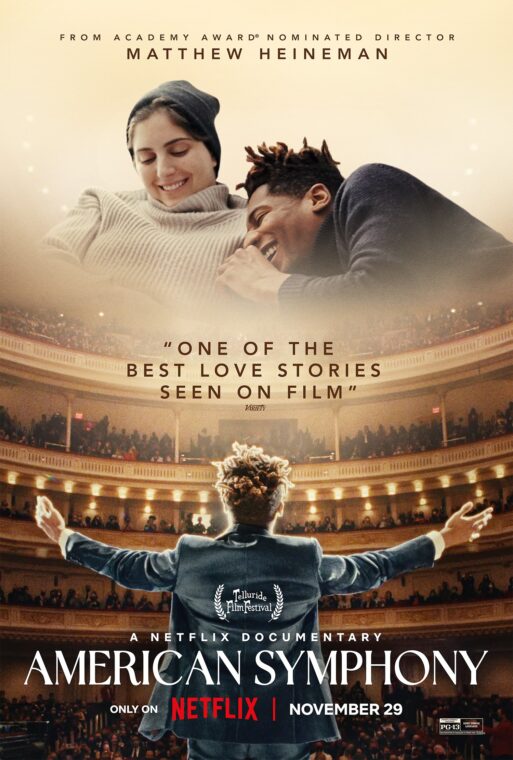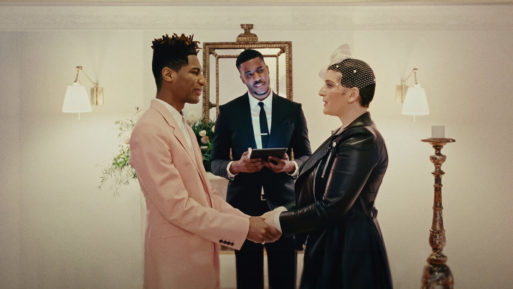 “American Symphony” follows two beloved, creative public personas through their relationship highs and lows: Suleika Jaouad, cancer survivor and author of the memoir “Between Two Kingdoms,” and Jon Batiste, an insanely talented musician. The film originally was meant to follow Batiste’s creative process as he attempted to write a symphony honoring people of color’s contributions to American music. But the focus of the documentary shifted when Jaouad discovered her leukemia had returned after more than ten years in remission.
“American Symphony” follows two beloved, creative public personas through their relationship highs and lows: Suleika Jaouad, cancer survivor and author of the memoir “Between Two Kingdoms,” and Jon Batiste, an insanely talented musician. The film originally was meant to follow Batiste’s creative process as he attempted to write a symphony honoring people of color’s contributions to American music. But the focus of the documentary shifted when Jaouad discovered her leukemia had returned after more than ten years in remission.
With this devastating turn of events, the film pivots to explore a “life in contrasts,” as the couple’s professional successes collide with private worry. The same week that Jaouad started chemo, Batiste was nominated for 11 Grammys. After the diagnosis, they had an intimate wedding at home; the next day, Jaouad checked into the hospital for her treatment and Batiste shaved her head in preparation for hair loss. While Jaouad underwent treatment, Batiste continued his day job as the bandleader on “The Stephen Colbert Show,” while also composing his symphony and touring for his album. In one poignant moment of the documentary, Batiste is on stage and pauses, dedicating his last song to Suleika. He sits still for an uncomfortably long moment, emotions crossing over his face, before breaking into passionate piano. Later, Batiste reflects on what it’s like to watch his wife suffer through cancer again, sharing, “I feel a strong, strong desire to take the pain away. But I can’t.”

Jaouad and Batiste at their home wedding before her treatment
Photo credit: Netflix
Jaouad and Batiste had met as teenagers at a music camp. In the film, Jaouad says, “Long before we were in a romantic relationship, Jon and I shared a creative language. We both see survival as its own kind of creative act. It’s what helps us alchemize the different things that come up in life and transform them into something useful and meaningful, and even beautiful.” The documentary shows how this is true for both of them. As Jaouad endures her second bone marrow transplant, she turns to drawing, while Batiste throws himself even more fully into his music. While “American Symphony” does follow Jaouad’s journey, it remains focused more fully on Batiste and how music becomes both his outlet and added pressure as he copes with Jaouad’s cancer. Batiste shares, “My mind is always making things. Just continues to become more and more of a survival mechanism as the years move on. It’s the way I process all the things in my life.” When Jaouad receives her transplant, Batiste plays music to commemorate the moment. While she is in the hospital, Batiste works furiously on his symphony, seeking out thematic elements of optimism and home.

Jon Batiste in 2018
Credit: Neil Grabowsky
Yet at some points, it feels painfully obvious that music has become not just a way of surviving this for Batiste, but an attempt to control something in a situation that is uncontrollable. The concerned viewer questions how he can continue to handle the immense professional pressures he places upon himself while also enduring the emotional pressure of supporting a wife through cancer. Batiste moves at a frenetic pace, always on the go, and his commitment to creating music through this difficult time feels both inspired and at times almost self-punishing. In rare moments of vulnerability, we see him having panic attacks and hear him on the phone with his therapist, buried under pillows.
The documentary stumbles a bit in that it fails to get at the emotional heart of what’s going on for both Batiste and Jaouad. There is an emotional wall up around them both, which the viewer never gets to fully see behind. Batiste feels a bit guarded, and Jaouad’s own emotional journey doesn’t feel fully fleshed out. This may also be due to the uncertain nature of Jaouad’s health. In speaking with the New York Times, Jaouad reflected, “When it comes to illness stories, we tell them from the vantage point of having survived. … It wasn’t clear that I was going to survive the shooting period of this.” The end of the documentary also contains the hard reality that we cannot guarantee a happy ending for a couple so deserving of one. Jaouad’s cancer goes into remission, but the doctor breaks the news that she will have to continue on chemo indefinitely, with regular scans. There are no easy answers for Jaouad and Batiste, but they go on creating through it all.

 “American Symphony” directed by Matthew Heineman
“American Symphony” directed by Matthew Heineman


 How Dare You Die Now!
How Dare You Die Now!
 Debating Medical Aid in Dying
Debating Medical Aid in Dying
 “Help Me, Helen”
“Help Me, Helen”














